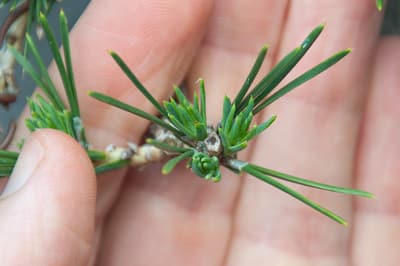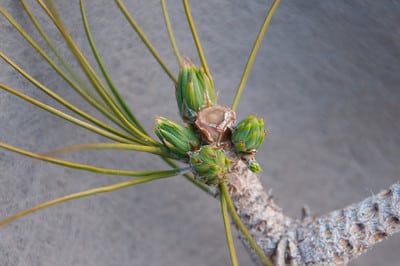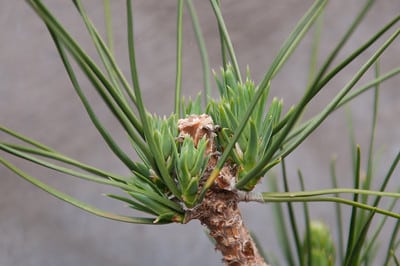In general, we want two new shoots at the end each branch to develop on black and red pine bonsai.

Red pine – two summer shoots
Nature, however, doesn’t always provide us with what we’re looking for.

Black pine – three shoots

Four summer shoots

More shoots than I want to count
One shoot can be acceptable – especially when that’s all we get – but three shoots are less so. It’s easy to fill a silhouette with branches that have three, four, five or more shoots each, but this isn’t always desirable. What are the benefits of branches with two shoots each?
- More attractive branch structure
- No unsightly knuckles
- Easy to maintain balanced branch density
- Easy to wire
Are there any exceptions? Definitely. It’s fine, for example, to leave more than two shoots when preparing a tree for exhibit if extra foliage is needed to improve the silhouette. I also occasionally leave three or more branches on trees in development knowing that I’ll thin out extra branches in the future.
What do I do when more than two summer buds appear after decandling? Usually nothing. I’ve seen magazines recommend thinning summer buds to two to save us the work of fall cutback and to avoid swelling that results from large numbers of buds that emerge from the same spot. I’m not sure, however, that removing extra buds in summer always produces the desired effect.
The appearance of more than two shoots on a single branch is an indication that the branch is fairly strong. In general, the more summer shoots we find, the stronger the branch. Looking at problem in terms of strength, the problem to be solved is not the number of shoots but how best to deal with excessive vigor.
Why not remove the extra shoots? Reducing the number of shoots can channel remaining vigor into a smaller number of branches, thereby producing even more vigorous growth on the remaining shoots. It’s often better to let the extra shoots develop through summer and remove them when they harden off in fall or winter.
What if there are five or more shoots – won’t that create a large knuckle? My main concern in these cases is not scars or the unsightly branch unions that may develop, but overall branch vigor. Unless it’s important to preserve the branch, I’m more likely to remove it entirely as there’s too much energy to be of use in a refined tree.
I’ll run through some examples in fall when this summer’s new growth hardens off and cutback season begins. In the meantime, see Pine cutback basics for a head start.
Subscribe to Bonsai Tonight
New Posts Delivered Every Tuesday and Friday
Joseph Gutierrez says
Your posts are excellent! Thank you very much – keep up the good work …
Joseph E. Gutierrez, MD, FACS
Mac says
Jonas, Another great tutorial on pine care. Many thanks for sharing your knowledge.
Evan says
Loving these articles, thanks for sharing with us.
Jeremiah Lee says
Legit! thanks for the breakdown.
Marty says
Jonas – Do you ever break summer shoots to equalize strength as you would do with spring shoots? Most of my Japanese Black and Red pines are early in development so there is often a huge difference in strength in the shoots. I anticipate that this difference will reduce as they mature, but there still may be significant differences.
Jonas Dupuich says
Hi Marty – interesting question. I have yet to break extra long summer shoots. Breaking growing shoots – as with candles in spring – removes the terminal bud. We can do this in spring because the shoots will come off at decandling time, but typically we want to keep the terminal buds on summer growth. Huge differences in vigor is natural in the early decandling years and is best addressed by removing the strong shoots much later than the weaker shoots.
Marty says
Thanks. I was thinking in comparison to single growth pines like Scots or Japanese White where we break the candles and still get buds near the break. Wondering if the summer candles on Black and Red were strong enough to do the same. Sounds like I will have to experiment a bit and document the results.